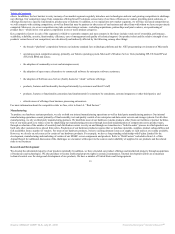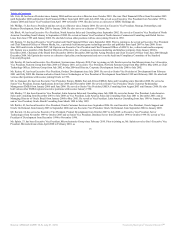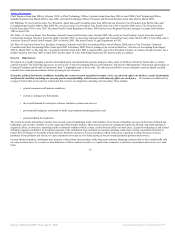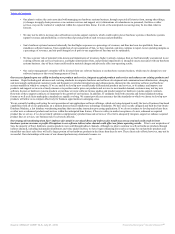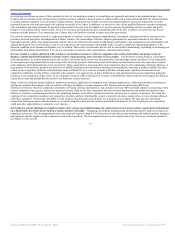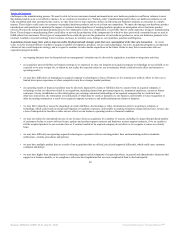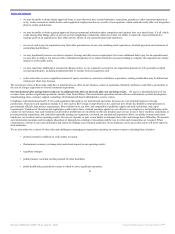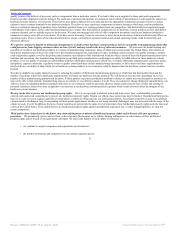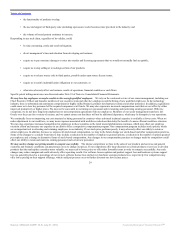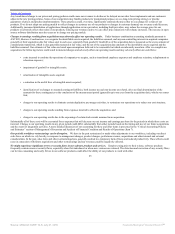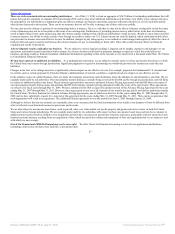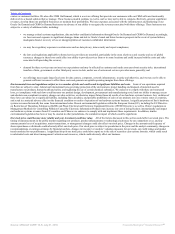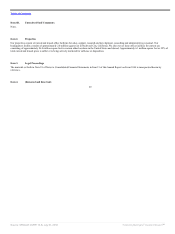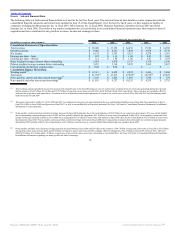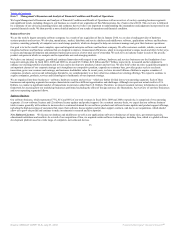Oracle 2009 Annual Report Download - page 27
Download and view the complete annual report
Please find page 27 of the 2009 Oracle annual report below. You can navigate through the pages in the report by either clicking on the pages listed below, or by using the keyword search tool below to find specific information within the annual report.
Table of Contents
quality issues in the delivery of necessary parts or components from a particular vendor. If we had to find a new supplier for these parts and components,
hardware product shipments could be delayed. We could also experience fluctuations in component prices which, if unanticipated, could negatively impact our
hardware systems business cost structure. These factors may make it difficult for us to plan and procure appropriate component inventory levels in a timely
fashion to meet customer demand for our hardware products. Therefore we may experience component inventory shortages which may result in production
delays or customers choosing to purchase fewer hardware products from us or systems products from our competitors. Sun historically has negotiated supply
commitments with vendors early in the manufacturing process to ensure they had sufficient components for its hardware systems products to meet anticipated
customer demand, and we initially expect to do the same. We must also manage our levels of older component inventories used in our hardware products to
minimize inventory write-offs or write-downs. If we have excess inventory, it may be necessary to write-down the inventory, which would adversely affect our
operating results. If one or more of the risks described above occurs, our hardware systems business and related operating results could be materially and
adversely affected.
We expect to continue to depend on third party manufacturers to build certain hardware systems products and are susceptible to manufacturing delays that
could prevent us from shipping customer orders on time, if at all, and may result in the loss of sales and customers. We outsource the manufacturing and
assembly of certain of our hardware products to a variety of manufacturing companies, many of which are located outside the United States. Our reliance on
third-party manufacturers reduces our control over the manufacturing process, exposing us to risks, including reduced control over quality assurance, product
costs and product supply as well as the political and economic uncertainties of the international locations where certain of these third-party manufacturers have
facilities and operations. Any manufacturing disruption by our third-party manufacturers could impair our ability to fulfill orders for these hardware systems
products. If we are unable to manage our relationships with these third-party manufacturers effectively, or if these third-party manufacturers experience delays,
disruptions, capacity constraints, regulatory issues or quality control problems in their manufacturing operations, or fail to meet our future requirements for
timely delivery, our ability to ship certain of our hardware systems products to our customers could be impaired and our hardware systems business could be
harmed.
We plan to simplify our supply chain processes by reducing the number of third party manufacturing partners on which Sun had historically relied and the
number of locations where these third party manufacturers will build our hardware systems products. We will therefore become more dependent on a fewer
number of these manufacturing partners and locations. If these partners experience production problems or delays or cannot meet our demand for products, we
may not be able to find alternate manufacturing sources in a timely or cost effective manner, if at all. If we are required to change third party manufacturers, our
ability to meet our scheduled hardware products deliveries to our customers could be adversely affected, which could cause the loss of sales and existing or
potential customers, delayed revenue recognition or an increase in our hardware systems products expenses which could adversely affect the margins of our
hardware systems business.
We may not be able to protect our intellectual property rights. We rely on copyright, trademark, patent and trade secret laws, confidentiality procedures,
controls and contractual commitments to protect our intellectual property rights. Despite our efforts, these protections may be limited. Unauthorized third parties
may try to copy or reverse engineer portions of our products or otherwise obtain and use our intellectual property. Any patents owned by us may be invalidated,
circumvented or challenged. Any of our pending or future patent applications, whether or not being currently challenged, may not be issued with the scope of the
claims we seek, if at all. In addition, the laws of some countries do not provide the same level of protection of our intellectual property rights as do the laws and
courts of the United States. If we cannot protect our intellectual property rights against unauthorized copying or use, or other misappropriation, we may not
remain competitive.
Third parties have claimed and, in the future, may claim infringement or misuse of intellectual property rights and/or breach of license agreement
provisions. We periodically receive notices from, or have lawsuits filed against us by, others claiming infringement or other misuse of their intellectual
property rights and/or breach of our agreements with them. We expect the number of such claims will increase as:
• we continue to acquire companies and expand into new businesses;
• the number of products and competitors in our industry segments grows;
23
Source: ORACLE CORP, 10-K, July 01, 2010 Powered by Morningstar® Document Research℠


